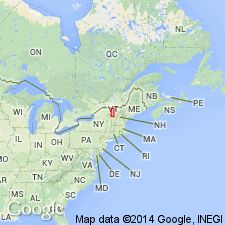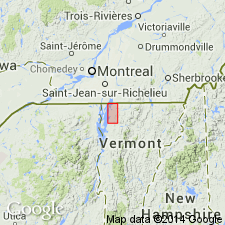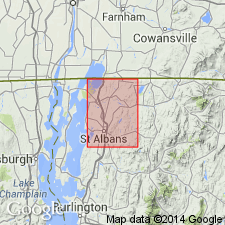
- Usage in publication:
-
- Highgate slate*
- Modifications:
-
- Named
- Dominant lithology:
-
- Slate
- Limestone
- AAPG geologic province:
-
- New England province
Summary:
Named the Highgate slate for Highgate Falls, Franklin Co., northwestern VT. Consists mainly of dark slate, in places black, usually banded. Banding in most places regular, sharp, and clear. The dark and light layers are evenly spaced and from 1/8 to 1/4 in. thick. Interbedded with the slate are many thin seams of fossiliferous blue limestone, 1 or 2 in. thick. One-third mile northwest of Highgate Center these layers thicken and outcrop in railroad cut as a strongly banded limestone mass 35 feet thick. These are probably highest beds in the formation near Highgate. In lower part at Highgate Falls the light bands consist of fine sandy shale or sandstone seams; there are several beds of tough gray dolomite, 1 foot or more thick, that weathers rusty brown; and about 40 feet above the base, there is a zone nearly 6 feet thick of slate filled with small pebbles of limestone up to 4 in. across. Thickness at Highgate Falls is at least 300 feet. Contains fossils of Late Cambrian age. At Highgate Falls section, unit overlies the Milton dolomite; nothing is know about overlying formations in this region.
Source: GNU records (USGS DDS-6; Reston GNULEX).

- Usage in publication:
-
- Highgate formation
- Modifications:
-
- Principal reference
- Revised
- Age modified
- Biostratigraphic dating
- AAPG geologic province:
-
- New England province
Summary:
Revised the Highgate to the Highgate formation and designated type locality. In type area, a tectonic breccia underlies the limestones and slates. Age is changed to Early Ordovician based on fossil data.
Source: GNU records (USGS DDS-6; Reston GNULEX).

- Usage in publication:
-
- Highgate formation
- Modifications:
-
- Principal reference
- Revised
- Redescribed
- AAPG geologic province:
-
- New England province
Summary:
Keith's first description of the Highgate included rocks now assigned to Highgate as well as parts of the Gorge formation, Hungerford slate, and Skeels Corners slate. Schuchert included certain Morses Line slates in the Highgate. Formation is defined to include beds named Grandge slate by Schuchert. Beds exposed below Highgate Falls (Schuchert's type locality) are now included in the Gorge formation; hence, new type locality is designated. Lowest Highgate beds lie above Highgate Falls thrust in north and east walls of Highgate Gorge. Several angular unconformities are present in formation. Section consists of lower limestone unit, 500 to 1000 feet thick; middle shaly unit, about 1500 feet thick; and an upper conglomerate and limestone. These units are gradational vertically through several hundred feet. Formation overlies Gorge formation and underlies Morses Line formation. The Highgate is of Early Ordovician age.
Source: GNU records (USGS DDS-6; Reston GNULEX).
For more information, please contact Nancy Stamm, Geologic Names Committee Secretary.
Asterisk (*) indicates published by U.S. Geological Survey authors.
"No current usage" (†) implies that a name has been abandoned or has fallen into disuse. Former usage and, if known, replacement name given in parentheses ( ).
Slash (/) indicates name conflicts with nomenclatural guidelines (CSN, 1933; ACSN, 1961, 1970; NACSN, 1983, 2005, 2021). May be explained within brackets ([ ]).

